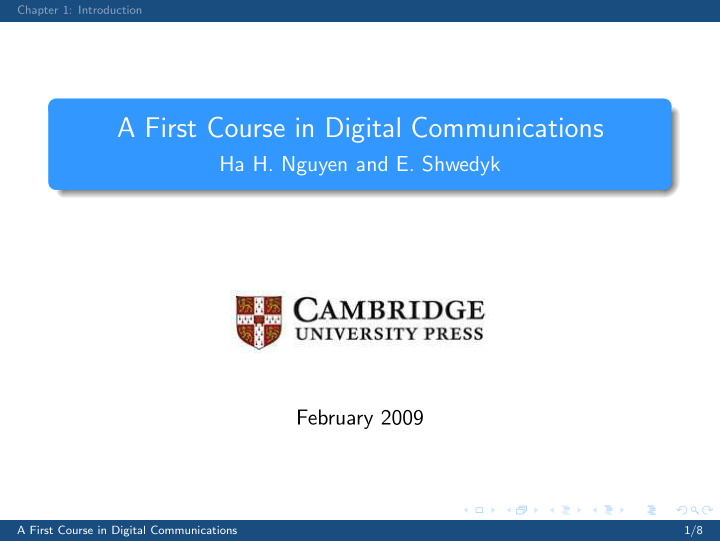



Chapter 1: Introduction A First Course in Digital Communications Ha H. Nguyen and E. Shwedyk February 2009 A First Course in Digital Communications 1/8
Chapter 1: Introduction Analog and Digital Amplitude Modulations Analog message 1 0 −1 0 0.5 1 1.5 2 2.5 3 3.5 4 4.5 5 t 1 AM signal 0 −1 0 0.5 1 1.5 2 2.5 3 3.5 4 4.5 5 t Digital message 1 0 −1 0 0.5 1 1.5 2 2.5 3 3.5 4 4.5 5 t BASK signal 1 0 −1 0 0.5 1 1.5 2 2.5 3 3.5 4 4.5 5 t A First Course in Digital Communications 2/8
Chapter 1: Introduction What is Digital Communication? � � � � � � � � � � � ��� ��� � � � � � � � � � � � � � � � � ��� ��� A First Course in Digital Communications 3/8
Chapter 1: Introduction Why Digital Communications? Transmitted AM 1 0 −1 0 0.5 1 1.5 2 2.5 3 3.5 4 4.5 5 t Received AM 2 0 −2 0 0.5 1 1.5 2 2.5 3 3.5 4 4.5 5 Transmitted BASK t 1 0 −1 0 0.5 1 1.5 2 2.5 3 3.5 4 4.5 5 t Received BASK 2 0 −2 0 0.5 1 1.5 2 2.5 3 3.5 4 4.5 5 t A First Course in Digital Communications 4/8
Chapter 1: Introduction Why Digital Communications? Transmitted AM 1 0 −1 0 0.5 1 1.5 2 2.5 3 3.5 4 4.5 5 t Received AM 5 0 −5 0 0.5 1 1.5 2 2.5 3 3.5 4 4.5 5 Transmitted BASK t 1 0 −1 0 0.5 1 1.5 2 2.5 3 3.5 4 4.5 5 t Received BASK 5 0 −5 0 0.5 1 1.5 2 2.5 3 3.5 4 4.5 5 t A First Course in Digital Communications 5/8
Chapter 1: Introduction Regenerative Repeater in Digital Communications �������� �������������� ��������������� �������� ����������� �������� � � � � � �������������������� Digital communications: Transmitted signals belong to a finite set of waveforms → The distorted signal can be recovered to its ideal shape, hence removing all the noise. Analog communications: Transmitted signals are analog waveforms, which can take infinite variety of shapes → Once the analog signal is distorted, the distortion cannot be removed. A First Course in Digital Communications 6/8
Chapter 1: Introduction Block Diagram of a Communication System ��������������� ������ ���� ����������� ������� �������� ������ ������ ��� ����������� �������� ������ ������� ��� ������� ������ ��������� ������� ������� ��������� ������� ������� ��� Note: “Synchronization” block is only present in a digital system. A First Course in Digital Communications 7/8
Chapter 1: Introduction Digital vs. Analog Advantages: Digital signals are much easier to be regenerated. Digital circuits are less subject to distortion and interference. Digital circuits are more reliable and can be produced at a lower cost than analog circuits. It is more flexible to implement digital hardware than analog hardware. Digital signals are beneficial from digital signal processing (DSP) techniques. Disadvantages: Heavy signal processing. Synchronization is crucial. Larger transmission bandwidth. Non-graceful degradation. A First Course in Digital Communications 8/8
Recommend
More recommend